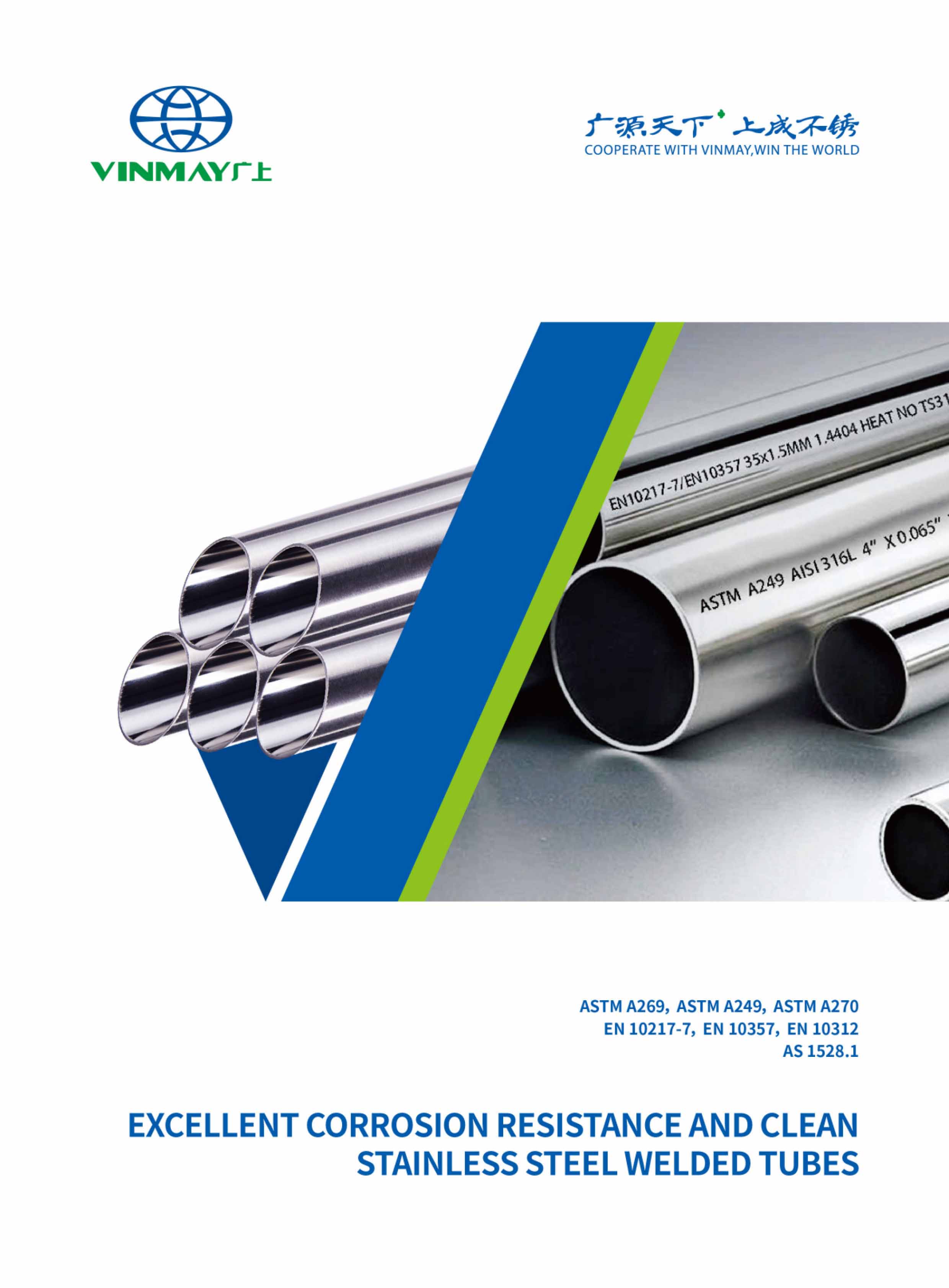Stainless steel pipes, composed of an iron-chromium alloy, offer superior corrosion resistance due to a passive oxide layer and deliver a lifespan exceeding 50 years. They retain higher tensile strength and impact resistance, but require complex shaping techniques and specialized welding methods. Conversely, galvanized pipes are carbon steel with a zinc coating for sacrificial protection against corrosion, generally lasting 20-50 years. Galvanized pipes are more malleable and cost-effective but necessitate rigorous maintenance. While stainless steel implies higher upfront costs, it lowers long-term maintenance expenses. Learn how each material's properties align with specific industrial applications.
Stainless steel pipes, composed of an iron-chromium alloy with additional elements such as nickel and molybdenum, are renowned for their exceptional strength, corrosion resistance, and durability across various industrial applications. The material composition, typically containing at least 10.5% chromium, forms a passive oxide layer, which greatly enhances corrosion resistance. This makes stainless steel pipes ideal for environments prone to chemical exposure, high humidity, and saline conditions.
From a cost comparison perspective, stainless steel pipes are more expensive than their galvanized counterparts, primarily due to the higher cost of alloying elements and the complex manufacturing process. However, the longevity benefits of stainless steel often justify the initial investment. These pipes exhibit superior durability and require less frequent replacement, reducing long-term maintenance costs.
Analyzing the environmental impact, stainless steel is generally more sustainable due to its recyclability and longer lifespan, which minimizes waste generation. Additionally, stainless steel's resilience against corrosion means fewer leaks and contamination risks in applications like water supply and food processing.
Click to learn more about stainless steel pipe dimensions.

Galvanized steel pipes, characterized by their zinc coating, offer a cost-effective and efficient solution for enhancing corrosion resistance and extending the service life of steel in various applications. These pipes undergo a galvanization process, where a layer of zinc is applied to the steel surface, providing robust rust prevention and ensuring durability, particularly in outdoor use. The zinc coating acts as a protective barrier, reducing the risk of corrosion when exposed to moisture and environmental elements.
| Feature | Description |
|---|---|
| Rust Prevention | Zinc coating prevents rust formation |
| Corrosion Resistance | Effective against general corrosion |
| Outdoor Use | Suitable for exposure to weather elements |
| Plumbing Applications | Commonly used in residential and commercial settings |
| Water Transportation | Ideal for transporting water, excluding saltwater |
Galvanized steel pipes are extensively utilized in plumbing applications, where they efficiently transport water and other fluids while remaining resistant to wear and tear. This makes them a preferred choice for water transportation systems, especially in residential and commercial settings. However, it is important to note that while galvanized pipes perform well in freshwater environments, they may corrode more rapidly in saline conditions. Hence, their application should be carefully considered based on environmental factors. These pipes provide a cost-effective balance between affordability and durability, making them a practical choice for many industries.
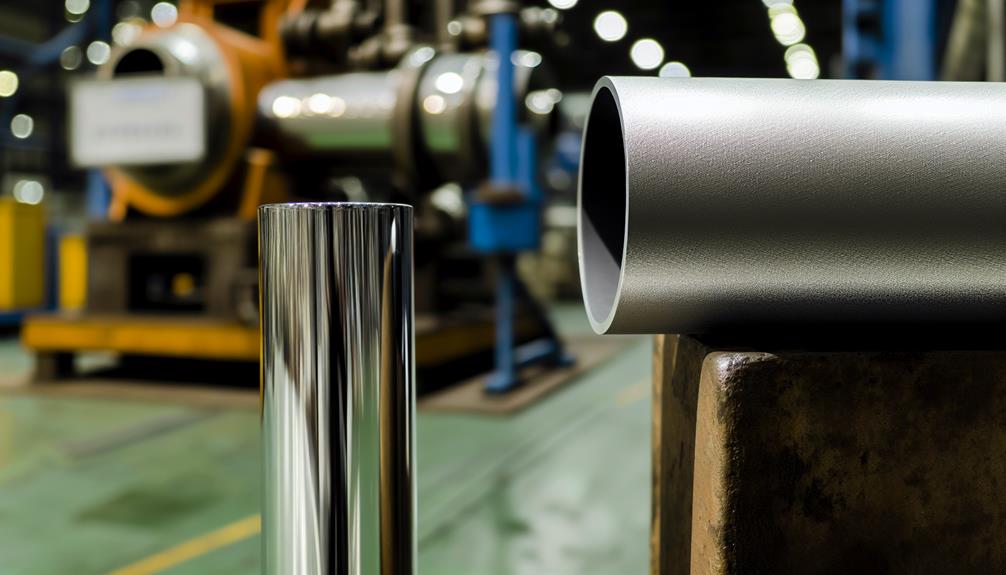
The key differences between stainless steel pipes and galvanized pipes are rooted in their formulation, corrosion resistance, and mechanical properties.
Stainless steel pipes, composed primarily of iron, chromium, and other alloying elements, offer superior corrosion resistance and higher strength compared to galvanized pipes, which are carbon steel pipes coated with zinc.
Additionally, while stainless steel pipes exhibit greater durability and flexibility, galvanized pipes are more economical and lighter, making them suitable for a range of applications where extreme corrosion resistance is not critical.
Understanding the formulation differences between stainless steel pipes and galvanized pipes is essential for selecting the appropriate material for specific industrial applications. The production methods for these two materials differ greatly.
Stainless steel pipes, often produced in a stainless steel tube factory, are made using a complex process that involves melting iron ore with chromium and other alloying elements in electric arc furnaces. This alloy composition grants stainless steel its renowned corrosion resistance and durability.
Stainless steel pipes are produced using a complex process that involves melting iron ore with chromium and other alloying elements in electric arc furnaces. This alloy composition grants stainless steel its renowned corrosion resistance and durability.
Conversely, galvanized steel pipes are manufactured by dipping carbon steel into molten zinc, creating a zinc coating that offers a protective barrier against corrosion.
A key distinction lies in their alloy composition. Stainless steel integrates elements such as chromium, nickel, and molybdenum, which contribute to its superior corrosion resistance and mechanical properties. In contrast, galvanized steel relies primarily on the zinc coating to prevent rust, making it less resilient in harsh environments.
From a price comparison perspective, stainless steel generally commands a higher cost due to its intricate production methods and enhanced performance characteristics. Understanding the nuances of stainless steel pipe manufacture and working with a reputable stainless steel tubing manufacturer is critical for industries requiring materials that offer both strength and longevity.
Recommended: Precision Stainless Steel Tubing Fabrication
Corrosion resistance in stainless steel pipes greatly surpasses that of galvanized pipes, primarily due to the inherent properties of their alloy compositions. Stainless steel, composed of iron, chromium, nickel, and other elements, forms a passive oxide layer that self-repairs, providing exceptional longevity in corrosive environments.
In contrast, galvanized pipes rely on a zinc coating that acts as a sacrificial layer, which, although effective, offers limited protection over time, especially in highly corrosive settings.
Key differences:
This analytical comparison underscores that for applications demanding superior corrosion resistance and long-term reliability, stainless steel is the preferred material.
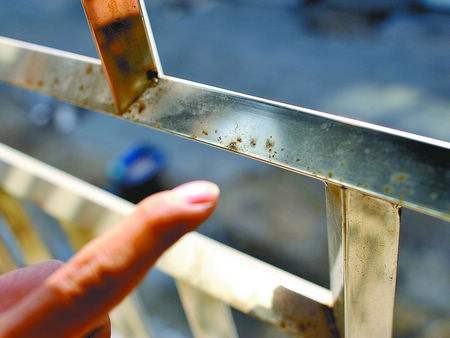
See Also - How to Prevent Stainless Steel Tube Corrosion
Evaluating the durability and lifespan of stainless steel pipes versus galvanized pipes reveals significant distinctions attributable to their material properties and manufacturing processes. Stainless steel pipes, composed primarily of iron, chromium, and other alloying elements, exhibit superior corrosion resistance, particularly in harsh environments. This resistance directly correlates with a longer lifespan, often exceeding 50 years under ideal conditions.
Conversely, galvanized pipes, coated with a layer of zinc, provide a degree of corrosion protection but are more susceptible to degradation, especially in saline or highly acidic environments, typically lasting 20-50 years.
A durability comparison highlights that stainless steel's inherent composition grants it higher tensile strength and better performance under stress, reducing the frequency of maintenance requirements. In contrast, galvanized pipes, while more affordable and easier to work with, require periodic inspection and potential re-galvanization to maintain structural integrity.
Lifespan analysis further demonstrates that stainless steel's robust nature minimizes long-term costs associated with repairs and replacements. A corrosion resistance study reinforces these findings, showing stainless steel's resilience against rust and oxidation. Ultimately, strength evaluation and maintenance requirements favor stainless steel in applications demanding durability and longevity.
When comparing the strength and flexibility of stainless steel pipes to galvanized pipes, stainless steel demonstrates considerably higher tensile strength and resistance to deformation under stress. Stainless steel's superior mechanical properties make it an ideal choice for applications demanding high durability and structural integrity.
Key differences in strength and flexibility include:
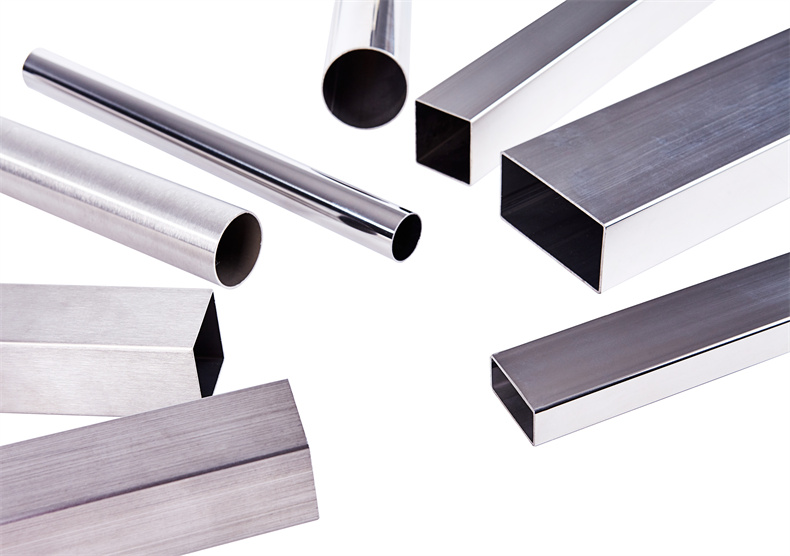
When examining the tensile strength and flexibility of stainless steel pipes compared to galvanized pipes, it is equally important to take into account the weight differences, which are largely influenced by the specific alloys and coating thicknesses involved. The weight comparison between these two materials hinges on their material composition and density differences.
Stainless steel, an alloy primarily of iron and chromium, has a higher density compared to carbon steel coated with zinc, used in galvanized pipes. The manufacturing process also impacts weight. Stainless steel involves a more complex process, including alloy variations that can lead to increased weight. Conversely, the weight of galvanized steel is affected by the zinc coating thickness, with heavier coatings adding significant weight.
From a strength analysis perspective, stainless steel offers superior strength and corrosion resistance factors, which may justify its higher density. However, the environmental impact and sustainability considerations of both materials must be assessed. Stainless steel, while heavier, often provides a longer service life and better recyclability, potentially offsetting its initial weight disadvantage.
Understanding the versatility and workability of stainless steel pipes versus galvanized pipes is essential for selecting the appropriate material for specific applications. A thorough material comparison reveals significant differences in malleability factors and forming techniques, which can influence the choice for various industrial applications.
Galvanized steel pipes, due to the zinc coating, retain the malleability of the underlying steel. This property makes them easier to shape and manipulate, particularly beneficial in metal fabrication techniques. Stainless steel pipes, on the other hand, are generally less malleable due to their complex alloy composition. However, specific austenitic grades, which contain higher nickel content, offer enhanced formability suitable for larger objects like sinks and tanks.
Key differences in malleability and workability include:
Choosing the appropriate material hinges on understanding these technical nuances and aligning them with project-specific requirements.
Both stainless steel pipes and galvanized pipes exhibit relatively similar thermal conductivity, making them suitable for applications requiring excellent heat tolerance. This similarity in heat transfer capabilities arises from the inherent material properties of steel in both types.
However, a closer conductivity comparison reveals nuanced differences owing to their distinct compositions. Stainless steel, an alloy enriched with chromium and other elements, offers consistent thermal resistance across a wide range of temperatures. This stability guarantees reliable performance in high-temperature environments without significant degradation.
In contrast, galvanized steel, coated with a thin layer of zinc, presents a different thermal resistance profile. While the underlying steel maintains its structural integrity under heat, the zinc coating has a lower melting point. Specifically, the zinc layer in galvanized steel begins to liquefy at approximately 419.5°C (787.1°F), potentially compromising the heat transfer efficiency and structural integrity of the pipe.
Therefore, while galvanized pipes are adequate for moderate temperature applications, their temperature tolerance is limited compared to stainless steel pipes.
Given the thermal conductivity properties of stainless steel and galvanized steel pipes, it is important to understand the distinct weldability considerations associated with each material. Both materials require specific welding techniques and careful management of heat exposure to maintain structural integrity and corrosion resistance.
Stainless steel welding can compromise the passive layer, leading to reduced corrosion resistance and potential brittleness. To mitigate these effects, pickling treatments are often employed post-welding to restore the material's protective properties.
Conversely, welding galvanized steel poses health hazards due to zinc oxide fumes, necessitating stringent ventilation requirements to protect welders. Additionally, molten zinc precautions are critical to prevent embrittlement of any adjacent stainless steel components during the welding process.
Key weldability considerations include:
Understanding these distinct considerations allows for informed decision-making and effective material handling during welding processes involving stainless steel and galvanized steel pipes.
Related Article:
Evaluating the magnetic properties of stainless steel and galvanized steel pipes reveals key differences contingent on the specific steel families and their respective iron content. The magnetic response of a steel pipe largely depends on its alloy composition.
For galvanized steel, the primary factor is the steel substrate; if the underlying steel is magnetic, the zinc coating typically does not interfere with its magnetic properties. Consequently, galvanized steel generally retains the magnetic characteristics of its base material.
In contrast, stainless steel exhibits a broader range of magnetic behaviors due to its diverse alloy compositions. Austenitic stainless steels, known for their high chromium and nickel content, exhibit weak magnetism or are virtually non-magnetic. Conversely, ferritic and martensitic stainless steels, with higher iron content and lower nickel levels, demonstrate stronger magnetic responses. The steel family influence is thus significant, with austenitic grades showing minimal magnetism compared to their ferritic and martensitic counterparts.
Alloy magnetism levels also vary within each family, influenced by specific element ratios. Understanding these distinctions is critical for applications where magnetic properties are pivotal, ensuring the best material selection based on precise magnetic performance requirements.
When evaluating the magnetic properties of stainless steel and galvanized steel pipes, it becomes apparent that cost considerations also play a pivotal role in material selection. Stainless steel generally commands a higher price due to its complex alloying processes and superior corrosion resistance.
A thorough cost analysis reveals that the price of stainless steel pipes is notably higher compared to galvanized steel pipes. This disparity is influenced by several factors, including production complexities and material properties.
Stainless steel's enhanced corrosion resistance and durability often justify its premium price for high-end applications. Budget implications of using stainless steel are substantial, particularly in large-scale projects, where cost efficiency is paramount.
Financial comparison between the two materials highlights a clear expense evaluation: stainless steel is ideal for long-term investment, while galvanized steel offers immediate cost savings.
Consequently, while stainless steel pipes offer superior performance, galvanized steel pipes present a more economical choice, catering to different budgetary and application-specific needs.
Consistently requiring less frequent upkeep, stainless steel pipes demonstrate superior maintenance efficiency compared to galvanized pipes. This advantage is primarily attributed to their inherent rust-prevention capabilities. Stainless steel's composition includes chromium, which forms a passive layer of chromium oxide, effectively safeguarding against corrosion and reducing the need for extensive surface maintenance.
In contrast, galvanized pipes, coated with zinc, necessitate regular inspections and more rigorous maintenance routines to guarantee the integrity of the protective layer. The zinc coating, while offering initial rust prevention, is susceptible to wear and tear, especially in harsh environments, requiring periodic reapplication and inspection to mitigate corrosion risks.
Cleaning techniques for stainless steel pipes are straightforward, often requiring only mild detergents and non-abrasive tools, thereby simplifying routine maintenance. Conversely, galvanized pipes may demand more complex cleaning procedures to prevent the zinc layer from degrading, potentially leading to increased maintenance costs over time.
Additionally, the longevity factors of stainless steel pipes surpass those of galvanized pipes, as they maintain structural integrity and appearance with minimal intervention. This longevity reduces overall maintenance efforts and ensures reliable performance, aligning with the needs of stakeholders who prioritize control and efficiency in their infrastructure investments.
The environmental impact of stainless steel pipes versus galvanized pipes can be assessed through their respective production processes, material longevity, and recyclability. An environmental impact analysis reveals significant differences between these two materials.
Stainless steel production, involving complex alloying with chromium and other elements, tends to have a higher ecological footprint due to energy-intensive electric arc furnaces. In contrast, galvanized steel, produced through zinc coating processes like hot-dipping, generally has a lower carbon emissions evaluation but shorter material longevity.
In terms of sustainability comparison, stainless steel's durability and resistance to corrosion contribute to extended service life, reducing the need for frequent replacements. This longevity factor is important for green construction considerations. Additionally, stainless steel is fully recyclable without degradation of properties, enhancing its ecological footprint assessment. Galvanized steel, while also recyclable, can lose its protective zinc layer over time, necessitating periodic re-coating.
This detailed analysis underscores the environmental advantages of stainless steel for sustainable applications.
Evaluating the pros and cons of stainless steel pipe versus galvanized steel reveals critical insights into their respective strengths, corrosion resistance, cost implications, and suitability for various applications.
Stainless steel, known for its superior corrosion resistance due to the inclusion of chromium, excels in environments exposed to moisture and chemicals. In contrast, galvanized steel, coated with a layer of zinc, provides temporary corrosion protection but is less effective in marine or industrial settings.
Strength comparison shows stainless steel as the superior material, offering higher tensile strength and durability, making it ideal for high-stress applications. Galvanized steel, while strong, is relatively more malleable and easier to work with, yet it cannot match the structural integrity of stainless steel.
Cost analysis reveals a significant disparity; stainless steel tends to be substantially more expensive, driven by its complex alloy composition and higher production costs. Galvanized steel, being more economical, is often the material of choice for budget-sensitive projects.
Regarding application suitability, stainless steel's robust properties make it a preferred option in medical, food processing, and high-end construction applications, whereas galvanized steel is commonly used in less demanding environments.
Lastly, the environmental impact of stainless steel is generally lower due to its recyclability and longer lifespan, reducing material turnover and waste.
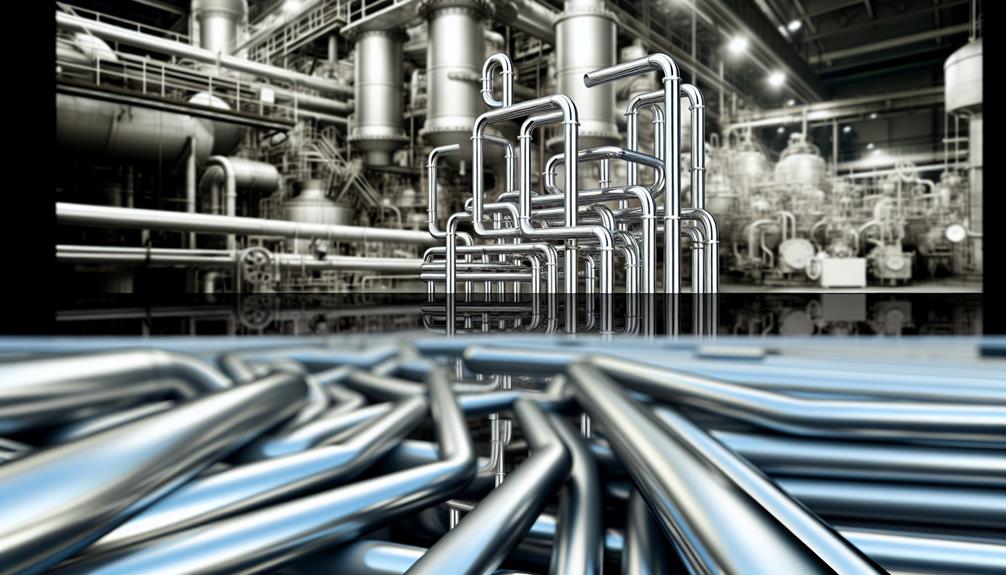
Widely utilized in industries requiring high corrosion resistance and strength, stainless steel pipes are integral to sectors such as pharmaceuticals, food processing, and petrochemical engineering. Their superior chemical resistance and ability to withstand high temperatures make them the material of choice for demanding environments.
Stainless steel pipes, including ornamental stainless steel tubes and sanitary stainless steel tubes, are mainly employed in applications where corrosion protection is paramount. This includes environments with exposure to aggressive chemicals, high humidity, and varying temperatures. Their versatility extends to structural applications where both strength and longevity are vital.
Analyzing these common applications, it becomes evident that stainless steel pipes offer unmatched reliability and performance in environments where control over material integrity is essential. The superior attributes of stainless steel make it indispensable for critical industrial applications.
Discover More:
Galvanized steel pipes, distinguished by their zinc coating, are primarily used in applications requiring strong protection against corrosion and physical damage. Their exceptional corrosion resistance makes them ideal for various outdoor applications, such as water and gas lines, where exposure to the elements is a notable concern. The zinc coating acts as a barrier, preventing rust formation and extending the service life of the pipes, thereby reducing maintenance requirements.
In terms of strength comparison, galvanized steel pipes offer sufficient robustness for many structural applications, including fencing, scaffolding, and support structures. Their utility is particularly noted in agricultural settings for irrigation systems and in residential construction for plumbing and drainage systems. Additionally, the protective zinc layer ensures that these pipes withstand harsh weather conditions and mechanical wear, making them a cost-effective solution for extensive outdoor use.
From a cost analysis perspective, galvanized steel pipes are more economical compared to their stainless steel counterparts, providing a budget-friendly option without compromising significantly on durability. Their lower initial costs, coupled with reduced maintenance needs, render them a practical choice for projects with stringent budget constraints while still requiring reliable performance.
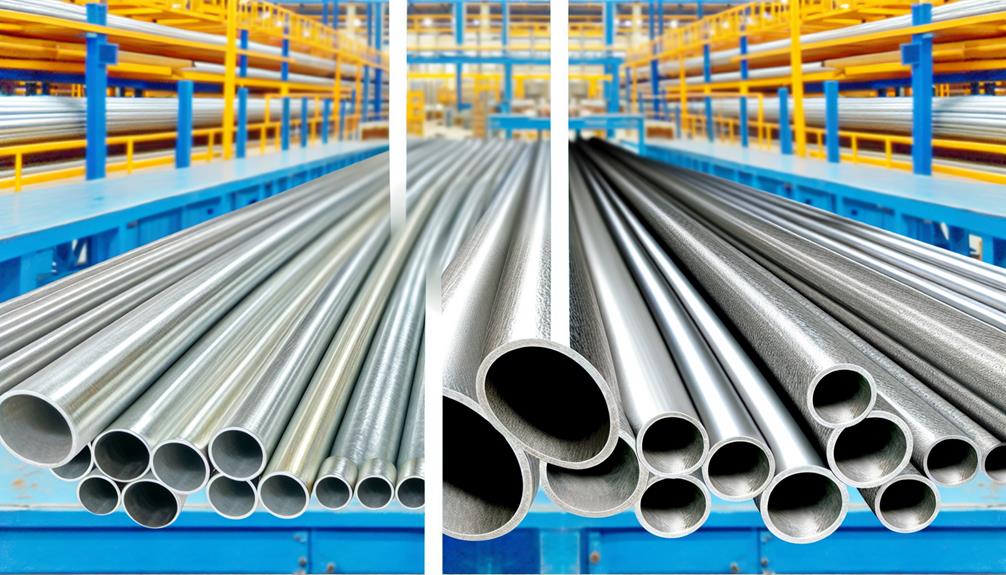
When deciding between stainless steel and galvanized steel pipes, it is important to evaluate factors such as corrosion resistance, strength, cost, and specific application requirements to guarantee the best material selection. The choice impacts not only the performance but also the longevity and reliability of the piping system.
Welding requirements distinctly differ due to divergent alloy compositions; stainless steel necessitates specific filler materials and heat treatments to maintain corrosion resistance, while galvanized steel demands techniques to manage zinc oxide fumes and guarantee proper bonding.
Learn More: Stainless Steel Welding Issues Exploration
Galvanized steel pipes often excel in agricultural applications, rural plumbing, and urban infrastructure due to their cost-effectiveness and adequate corrosion resistance. However, in coastal areas and industrial settings, stainless steel pipes are generally superior.
To prolong the life of galvanized steel pipes, maintain regular cleaning frequency, apply corrosion inhibitors and protective coatings, utilize pipe insulation, and guarantee water filtration to minimize impurities that accelerate corrosion. These practices enhance durability and performance.
Choosing between stainless steel and galvanized pipes is akin to selecting between a marathon and a sprint. Despite the higher initial investment, stainless steel's superior corrosion resistance and longevity factors often outweigh the price fluctuations in long-term cost analysis.
When considering health and safety, stainless steel offers superior corrosion resistance and lower risk of chemical leaching, while galvanized pipes may emit toxic fumes during welding. Both types require precautions against fire hazards and proper handling of pipe coatings.
In the domain of piping materials, the choice between stainless steel and galvanized steel is akin to selecting the keystone for an arch, pivotal to structural integrity.
Stainless steel pipes, with unparalleled corrosion resistance and strength, cater to specialized, high-end applications.
Galvanized steel, offering economical rust protection, suits broader, general uses.
Therefore, the decision hinges on balancing cost, durability, and specific performance requirements, ensuring the selected material aligns with the project's long-term objectives.
Read More: Stainless Steel Pipe Vs Galvanized: Key Differences Explained

